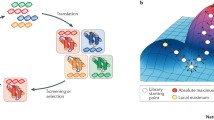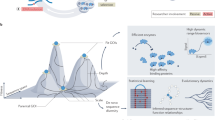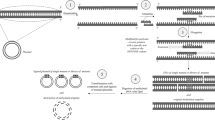Abstract
Directed evolution of proteins for improved or modified functionality is an important branch of modern biotechnology. It has traditionally been performed using various in vitro methods, but more recently, methods of in vivo artificial evolution come into play. In this review, we discuss and compare prokaryotic and eukaryotic-based systems of directed protein evolution in vivo, highlighting their benefits and current limitations and focusing on the biotechnological potential of vertebrate immune cells for the generation of protein diversity by means of the immunoglobulin diversification machinery.

Similar content being viewed by others
Abbreviations
- AID:
-
Activation-induced deaminase
- BFP:
-
Blue fluorescent protein
- EGFP:
-
Enhanced GFP
- FACS:
-
Fluorescence-activated cell sorting
- GFP:
-
Green fluorescent protein
- GPCR:
-
G protein-coupled receptor
- IPTG:
-
Isopropyl β-d-1-thiogalactopyranoside
- mRFP:
-
Monomeric red fluorescent protein
- PCR:
-
Polymerase chain reaction
- TSA:
-
Trichostatin A
References
Kaur J, Sharma R (2006) Directed evolution: an approach to engineer enzymes. Crit Rev Biotechnol 26(3):165–199. doi:10.1080/07388550600851423
Jackel C, Kast P, Hilvert D (2008) Protein design by directed evolution. Annu Rev Biophys 37:153–173. doi:10.1146/annurev.biophys.37.032807.125832
Bottcher D, Bornscheuer UT Protein engineering of microbial enzymes. Curr Opin Microbiol 13 (3):274–282. S1369-5274(10)00015-9 [pii]
Dougherty MJ, Arnold FH (2009) Directed evolution: new parts and optimized function. Curr Opin Biotechnol 20(4):486–491. doi:10.1016/j.copbio.2009.08.005
Stemmer WP (1994) Rapid evolution of a protein in vitro by DNA shuffling. Nature 370(6488):389–391. doi:10.1038/370389a0
Ness JE, Welch M, Giver L, Bueno M, Cherry JR, Borchert TV, Stemmer WP, Minshull J (1999) DNA shuffling of subgenomic sequences of subtilisin. Nat Biotechnol 17(9):893–896. doi:10.1038/12884
Harayama S (1998) Artificial evolution by DNA shuffling. Trends Biotechnol 16(2):76–82. S0167-7799(97)01158-X [pii]
Shen B (2002) PCR approaches to DNA mutagenesis and recombination. An overview. Methods Mol Biol 192:167–174. doi:10.1385/1-59259-177-9:167
Matsuura T, Yomo T (2006) In vitro evolution of proteins. J Biosci Bioeng 101(6):449–456. doi:10.1263/jbb.101.449
Lipovsek D, Pluckthun A (2004) In vitro protein evolution by ribosome display and mRNA display. J Immunol Methods 290(1–2):51–67. doi:10.1016/j.jim.2004.04.008
Smith GP, Petrenko VA (1997) Phage display. Chem Rev 97(2):391–410
Labrou NE (2010) Random mutagenesis methods for in vitro directed enzyme evolution. Curr Protein Pept Sci 11(1):91–100
Stemmer WP (1994) DNA shuffling by random fragmentation and reassembly: in vitro recombination for molecular evolution. Proc Natl Acad Sci USA 91(22):10747–10751
Cirino PC, Mayer KM, Umeno D (2003) Generating mutant libraries using error-prone PCR. Methods Mol Biol 231:3–9. doi:10.1385/1-59259-395-X:3
Sarkar CA, Dodevski I, Kenig M, Dudli S, Mohr A, Hermans E, Pluckthun A (2008) Directed evolution of a G protein-coupled receptor for expression, stability, and binding selectivity. Proc Natl Acad Sci USA 105(39):14808–14813. doi:10.1073/pnas.0803103105
Liu R, Barrick JE, Szostak JW, Roberts RW (2000) Optimized synthesis of RNA-protein fusions for in vitro protein selection. Methods Enzymol 318:268–293
Hanes J, Pluckthun A (1997) In vitro selection and evolution of functional proteins by using ribosome display. Proc Natl Acad Sci USA 94(10):4937–4942
Spirin AS (2004) High-throughput cell-free systems for synthesis of functionally active proteins. Trends Biotechnol 22(10):538–545. doi:10.1016/j.tibtech.2004.08.012
Greener A, Callahan M, Jerpseth B (1996) An efficient random mutagenesis technique using an E. coli mutator strain. Methods Mol Biol 57:375–385. doi:10.1385/0-89603-332-5:375
Chusacultanachai S, Yuthavong Y (2004) Random mutagenesis strategies for construction of large and diverse clone libraries of mutated DNA fragments. Methods Mol Biol 270:319–334. doi:10.1385/1-59259-793-9:319
Bornscheuer UT, Altenbuchner J, Meyer HH (1998) Directed evolution of an esterase for the stereoselective resolution of a key intermediate in the synthesis of epothilones. Biotechnol Bioeng 58(5):554–559. doi:10.1002/(SICI)1097-0290(19980605)58:5<554::AID-BIT12>3.0.CO;2-B
Bornscheuer UT, Altenbuchner J, Meyer HH (1999) Directed evolution of an esterase: screening of enzyme libraries based on pH indicators and a growth assay. Bioorg Med Chem 7(10):2169–2173. S0968-0896(99)00147-9 [pii]
Callanan MJ, Russell WM, Klaenhammer TR (2007) Modification of Lactobacillus beta-glucuronidase activity by random mutagenesis. Gene 389(2):122–127. doi:10.1016/j.gene.2006.10.022
Lu X, Hirata H, Yamaji Y, Ugaki M, Namba S (2001) Random mutagenesis in a plant viral genome using a DNA repair-deficient mutator Escherichia coli strain. J Virol Methods 94(1–2):37–43. S0166093401002701 [pii]
Nakashima N, Tamura T (2009) Conditional gene silencing of multiple genes with antisense RNAs and generation of a mutator strain of Escherichia coli. Nucleic Acids Res 37(15):e103. doi:10.1093/nar/gkp498
Yang H, Miller JH (2008) Deletion of dnaN1 generates a mutator phenotype in Bacillus anthracis. DNA Repair (Amst) 7(3):507–514. doi:10.1016/j.dnarep.2007.10.003
Camps M, Naukkarinen J, Johnson BP, Loeb LA (2003) Targeted gene evolution in Escherichia coli using a highly error-prone DNA polymerase I. Proc Natl Acad Sci USA 100(17):9727–9732. doi:10.1073/pnas.1333928100
Itoh T, Tomizawa J (1979) Initiation of replication of plasmid ColE1 DNA by RNA polymerase, ribonuclease H, and DNA polymerase I. Cold Spring Harb Symp Quant Biol 43(Pt 1):409–417
Wang HH, Isaacs FJ, Carr PA, Sun ZZ, Xu G, Forest CR, Church GM (2009) Programming cells by multiplex genome engineering and accelerated evolution. Nature 460(7257):894–898. doi:10.1038/nature08187
Ellis HM, Yu D, DiTizio T, Court DL (2001) High efficiency mutagenesis, repair, and engineering of chromosomal DNA using single-stranded oligonucleotides. Proc Natl Acad Sci USA 98(12):6742–6746. doi:10.1073/pnas.121164898
Pirakitikulr N, Ostrov N, Peralta-Yahya P, Cornish VW PCR less library mutagenesis via oligonucleotide recombination in yeast. Protein Sci 19(12):2336–2346. doi:10.1002/pro.513
Weigert MG, Cesari IM, Yonkovich SJ, Cohn M (1970) Variability in the lambda light chain sequences of mouse antibody. Nature 228(5276):1045–1047
Kim S, Davis M, Sinn E, Patten P, Hood L (1981) Antibody diversity: somatic hypermutation of rearranged VH genes. Cell 27(3 Pt 2):573–581. doi:0092-8674(81)90399-8
McKean D, Huppi K, Bell M, Staudt L, Gerhard W, Weigert M (1984) Generation of antibody diversity in the immune response of BALB/c mice to influenza virus hemagglutinin. Proc Natl Acad Sci USA 81(10):3180–3184
Milstein C, Rada C (1995) The maturation of the antibody response. In: Honjo T, Alt F (eds) Immunoglobulin genes. Academic Press Limited, London, pp 57–83
Papavasiliou FN, Schatz DG (2002) Somatic hypermutation of immunoglobulin genes: merging mechanisms for genetic diversity. Cell 109(Suppl):S35–S44
Martin A, Scharff MD (2002) AID and mismatch repair in antibody diversification. Nat Rev Immunol 2(8):605–614. doi:10.1038/nri858
Neuberger MS, Harris RS, Di Noia J, Petersen-Mahrt SK (2003) Immunity through DNA deamination. Trends Biochem Sci 28(6):305–312. S0968000403001117 [pii]
Rajewsky K, Forster I, Cumano A (1987) Evolutionary and somatic selection of the antibody repertoire in the mouse. Science 238(4830):1088–1094
Muramatsu M, Kinoshita K, Fagarasan S, Yamada S, Shinkai Y, Honjo T (2000) Class switch recombination and hypermutation require activation-induced cytidine deaminase (AID), a potential RNA editing enzyme. Cell 102(5):553–563. S0092-8674(00)00078-7 [pii]
Bransteitter R, Pham P, Scharff MD, Goodman MF (2003) Activation-induced cytidine deaminase deaminates deoxycytidine on single-stranded DNA but requires the action of RNase. Proc Natl Acad Sci USA 100(7):4102–4107. doi:10.1073/pnas.0730835100
Pham P, Bransteitter R, Petruska J, Goodman MF (2003) Processive AID-catalysed cytosine deamination on single-stranded DNA simulates somatic hypermutation. Nature 424(6944):103–107. doi:10.1038/nature01760
Peters A, Storb U (1996) Somatic hypermutation of immunoglobulin genes is linked to transcription initiation. Immunity 4(1):57–65. doi:S1074-7613(00)80298-8
Cascalho M, Wong J, Steinberg C, Wabl M (1998) Mismatch repair co-opted by hypermutation. Science 279(5354):1207–1210
Di Noia J, Neuberger MS (2002) Altering the pathway of immunoglobulin hypermutation by inhibiting uracil-DNA glycosylase. Nature 419(6902):43–48. doi:10.1038/nature00981
Petersen-Mahrt SK, Harris RS, Neuberger MS (2002) AID mutates E. coli suggesting a DNA deamination mechanism for antibody diversification. Nature 418(6893):99–103. doi:10.1038/nature00862
Yelamos J, Klix N, Goyenechea B, Lozano F, Chui YL, Gonzalez Fernandez A, Pannell R, Neuberger MS, Milstein C (1995) Targeting of non-Ig sequences in place of the V segment by somatic hypermutation. Nature 376(6537):225–229. doi:10.1038/376225a0
Bachl J, Carlson C, Gray-Schopfer V, Dessing M, Olsson C (2001) Increased transcription levels induce higher mutation rates in a hypermutating cell line. J Immunol 166(8):5051–5057
Yoshikawa K, Okazaki IM, Eto T, Kinoshita K, Muramatsu M, Nagaoka H, Honjo T (2002) AID enzyme-induced hypermutation in an actively transcribed gene in fibroblasts. Science 296(5575):2033–2036. doi:10.1126/science.1071556
Campbell RE, Tour O, Palmer AE, Steinbach PA, Baird GS, Zacharias DA, Tsien RY (2002) A monomeric red fluorescent protein. Proc Natl Acad Sci USA 99(12):7877–7882. doi:10.1073/pnas.082243699;99/12/7877
Sale JE, Neuberger MS (1998) TdT-accessible breaks are scattered over the immunoglobulin V domain in a constitutively hypermutating B cell line. Immunity 9(6):859–869. S1074-7613(00)80651-2 [pii]
Wang L, Jackson WC, Steinbach PA, Tsien RY (2004) Evolution of new nonantibody proteins via iterative somatic hypermutation. Proc Natl Acad Sci USA 101(48):16745–16749. doi:10.1073/pnas.0407752101
Arakawa H, Hauschild J, Buerstedde JM (2002) Requirement of the activation-induced deaminase (AID) gene for immunoglobulin gene conversion. Science 295(5558):1301–1306. doi:10.1126/science.1067308
Arakawa H, Saribasak H, Buerstedde JM (2004) Activation-induced cytidine deaminase initiates immunoglobulin gene conversion and hypermutation by a common intermediate. PLoS Biol 2(7):E179. doi:10.1371/journal.pbio.0020179
Buerstedde JM, Takeda S (1991) Increased ratio of targeted to random integration after transfection of chicken B cell lines. Cell 67(1):179–188. doi:0092-8674(91)90581-I
Seo H, Masuoka M, Murofushi H, Takeda S, Shibata T, Ohta K (2005) Rapid generation of specific antibodies by enhanced homologous recombination. Nat Biotechnol 23(6):731–735. doi:10.1038/nbt1092
Seo H, Hashimoto S, Tsuchiya K, Lin W, Shibata T, Ohta K (2006) An ex vivo method for rapid generation of monoclonal antibodies (ADLib system). Nat Protoc 1(3):1502–1506. doi:10.1038/nprot.2006.248
Seo H, Yamada T, Hashimoto S, Lin W, Ohta K (2007) Modulation of immunoglobulin gene conversion in chicken DT40 by enhancing histone acetylation, and its application to antibody engineering. Biotechnol Genet Eng Rev 24:179–193
Kanayama N, Todo K, Takahashi S, Magari M, Ohmori H (2006) Genetic manipulation of an exogenous non-immunoglobulin protein by gene conversion machinery in a chicken B cell line. Nucleic Acids Res 34(2):e10. 34/2/e10 [pii]
Arakawa H, Kudo H, Batrak V, Caldwell RB, Rieger MA, Ellwart JW, Buerstedde JM (2008) Protein evolution by hypermutation and selection in the B cell line DT40. Nucleic Acids Res 36(1):e1. doi:10.1093/nar/gkm616
Arakawa H, Lodygin D, Buerstedde JM (2001) Mutant loxP vectors for selectable marker recycle and conditional knock-outs. BMC Biotechnol 1:7
Betz AG, Milstein C, Gonzalez-Fernandez A, Pannell R, Larson T, Neuberger MS (1994) Elements regulating somatic hypermutation of an immunoglobulin kappa gene: critical role for the intron enhancer/matrix attachment region. Cell 77(2):239–248. 0092-8674(94)90316-6 [pii]
Odegard VH, Schatz DG (2006) Targeting of somatic hypermutation. Nat Rev Immunol 6(8):573–583. doi:10.1038/nri1896
Kothapalli N, Norton DD, Fugmann SD (2008) Cutting edge: a cis-acting DNA element targets AID-mediated sequence diversification to the chicken Ig light chain gene locus. J Immunol 180(4):2019–2023. 180/4/2019 [pii]
Blagodatski A, Batrak V, Schmidl S, Schoetz U, Caldwell RB, Arakawa H, Buerstedde JM (2009) A cis-acting diversification activator both necessary and sufficient for AID-mediated hypermutation. PLoS Genet 5(1):e1000332. doi:10.1371/journal.pgen.1000332
Arakawa H, Buerstedde JM (2009) Activation-induced cytidine deaminase-mediated hypermutation in the DT40 cell line. Philos Trans R Soc Lond B Biol Sci 364(1517):639–644. doi:10.1098/rstb.2008.0202
Acknowledgments
The work was supported by grant No. 02.740.11.5016 from the Russian Ministry of Science and by Deutsche Forschungsgemeinschaft (TR SFB-11) to V.L.K. A.B. is a recipient of the Russian state scholarship No. 8084 p/12612 “Participant of the Youth Contest for Science and Innovation”.
Author information
Authors and Affiliations
Corresponding author
Rights and permissions
About this article
Cite this article
Blagodatski, A., Katanaev, V.L. Technologies of directed protein evolution in vivo. Cell. Mol. Life Sci. 68, 1207–1214 (2011). https://doi.org/10.1007/s00018-010-0610-5
Received:
Revised:
Accepted:
Published:
Issue Date:
DOI: https://doi.org/10.1007/s00018-010-0610-5




